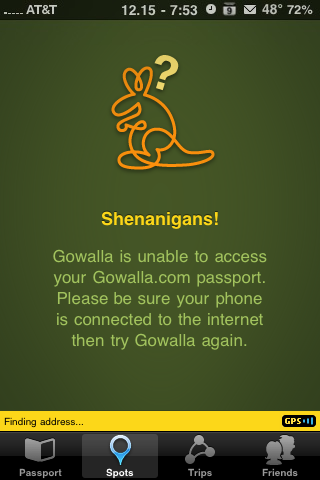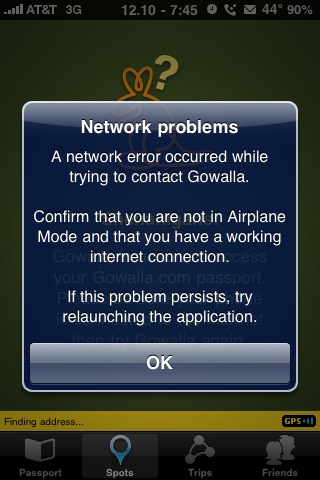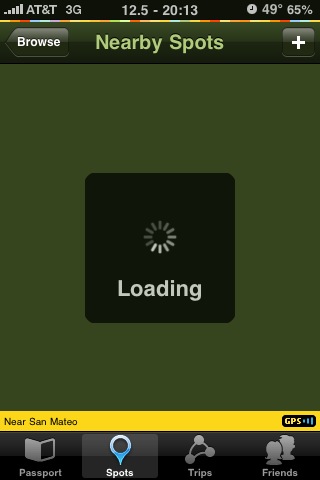|
Because international users may not want to pay for data use on the currently overpriced roaming plans currently available, and because the 'net just isn't available everywhere I happen to be (even in San Francisco), another vision for Gowalla would be to download all the Spots within some radius of your current location, along with the checked-in status, and the bounding box for allowed check-in, and work in an offline mode when GPS is available but not the 'net.
When it notices the 'net is back, it could update. This might offload some of the lag into your smartphone and off the network.
|
Gowalla, in this incarnation, assumes that you have a somewhat-robust connection to the Internet. (See the box at right for another view of Gowalla's relationship to spotty network availability.)
Gowalla downloads near-by Spots, checks whether you've visited them before, and then displays them. In dense urban enviroments, with lots of Gowallaers, and with less-than-grand network bandwidth, this can cause quite a bit of lag in getting updates.
These are some of the things Gowalla does when it doesn't find the network upon which it depends.

 Generally, the way one notices a drop in network connectivity is the Shenanigans kangaroo on the Spots page (despite the message saying it's trying to access your passport). I've never seen Gowalla re-try from this state; I need to quit and restart Gowalla to continue.
Generally, the way one notices a drop in network connectivity is the Shenanigans kangaroo on the Spots page (despite the message saying it's trying to access your passport). I've never seen Gowalla re-try from this state; I need to quit and restart Gowalla to continue.
As you can see from the screenshot, this happens even when the iPhone thinks it's connected to the AT&T network. (It's less surprising when I see the "Searching..." text instead of the network strength indicator bars.
(It would be nice to see a countdown timer to a retry, but perhaps that might be for a future version of Gowalla.)
When Gowalla believes it has network connectivity (but either doesn't or there's an issue at the Gowalla servers) you'll see some variant of the loading page, or when happens when Gowalla gives up, the blank page.

 At this stage of things I find I have to restart the Gowalla application.
At this stage of things I find I have to restart the Gowalla application.
This state is rather uncommon, but I include it here just so it's not a surprise.
(The hilly character of San Francisco seems to breed dead zones within AT&T's coverage, so it's something I see at least weekly.)
 subscribe
subscribe
 subscribe
subscribe